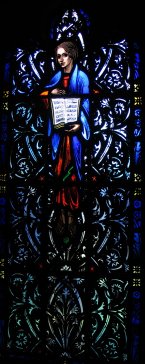
Architectural Glass
Introduction
Albert M. Tannler
Historical Collections Director (1991-2019),
Pittsburgh History & Landmarks Foundation
Architectural stained glass is a dangerously neglected field in the United States, especially in comparison to its study by European agencies. Such neglect extends to the fragile nature of the medium itself; many of the windows are over a century old and have never been repaired. Once lost, the loss is permanent. The very nature of the medium, at once craft product, an architectural element, and a figural image, disturbs the comfortable categories of contemporary art. . . . Yet, glass may be possibly the most wide-spread public art form, certainly far more ubiquitous than public sculpture or mural painting in our country.
Glory in Glass exhibition catalog (American Bible Society 1999)

Today it is likely that more people associate Chicago with Louis Sullivan and Frank Lloyd Wright than with Al Capone. Pittsburgh, outside the “buzz” of fashionable scrutiny, retains its identification with heavy industry. Visitors are likely to reassess the stereotype. Peter Cormack, Honorary Fellow of the British Society of Master Glass Painters, and an authority on 19th- and 20th-century stained glass, visited Pittsburgh in 2001 and spoke of its “magnificent heritage of architecture and stained glass.” The leader of the 2005 National Trust Study Tour of Pittsburgh wrote to me that the group I had led on an architectural tour of Pittsburgh “kept raving over the wonders of Pittsburgh. Everyone kept saying ‘I had no idea…..’”Pittsburgh’s superb ornamental and stained glass is the city’s most significant public art form. Although undocumented and unreliable, Virginia Lewis’s “Stained Glass in Pittsburgh,” Stained Glass (1948) remained the standard treatment for many years. The serious assessment of stained glass in Pittsburgh began when the Pittsburgh History & Landmarks Foundation (Landmarks) mounted Stained Glass in Pittsburgh, an exhibition held at the Old Post Office Museum in May 1976. Matthew Roper’s article, “Stained Glass in Pittsburgh: Styles, Techniques, Innovators,” Carnegie Magazine 1978 was a useful overview, despite repeating some of Lewis’s factual errors. Little of substance was written until the mid-1990s when free-lance writer Joan Gaul and I began to explore the work of Pittsburgh glass firms, and I wrote about Pittsburgh buildings with glass by important artists from Boston, Chicago, and New York. Curator Anne Madarasz mounted an exhibition on regional glass manufacturing at the Historical Society of Western Pennsylvania; the catalog, Glass: Shattering Notions, appeared in 1998.

This website has been created to provide a readily accessible means of presenting research and analysis. “Eight Glass Artists in Nine Pittsburgh-area Buildings 1883-1962” is our initial presentation. Other illustrated articles will be added from time to time.
A select bibliography of recent articles and books about architectural glass and glass artists in the Pittsburgh-area is available on this website.
Send comments or requests for further information to Al Tannler, al@phlf.org.
